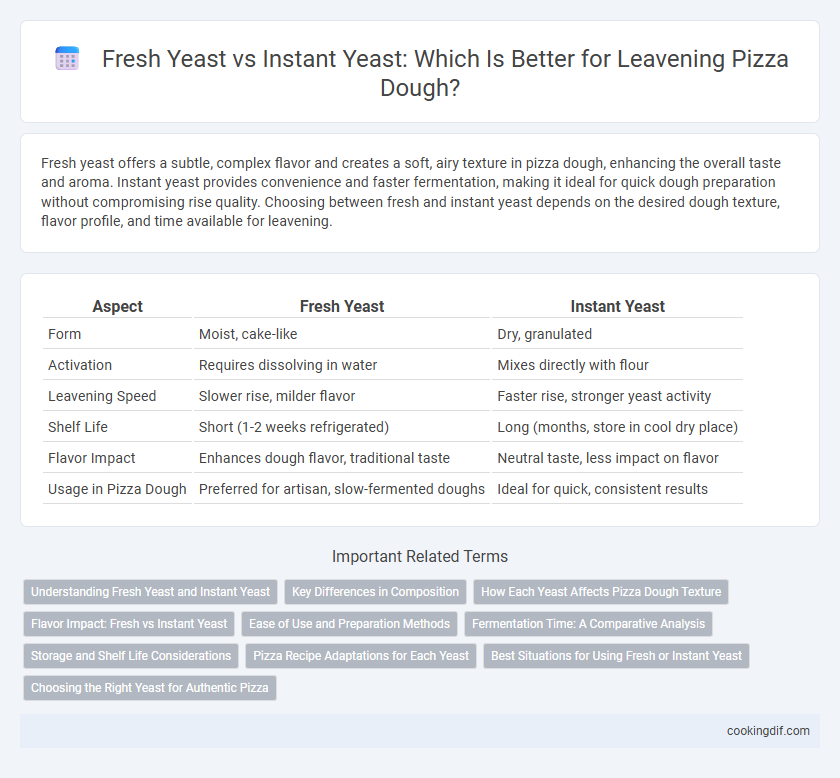Fresh yeast offers a subtle, complex flavor and creates a soft, airy texture in pizza dough, enhancing the overall taste and aroma. Instant yeast provides convenience and faster fermentation, making it ideal for quick dough preparation without compromising rise quality. Choosing between fresh and instant yeast depends on the desired dough texture, flavor profile, and time available for leavening.
Table of Comparison
| Aspect | Fresh Yeast | Instant Yeast |
|---|---|---|
| Form | Moist, cake-like | Dry, granulated |
| Activation | Requires dissolving in water | Mixes directly with flour |
| Leavening Speed | Slower rise, milder flavor | Faster rise, stronger yeast activity |
| Shelf Life | Short (1-2 weeks refrigerated) | Long (months, store in cool dry place) |
| Flavor Impact | Enhances dough flavor, traditional taste | Neutral taste, less impact on flavor |
| Usage in Pizza Dough | Preferred for artisan, slow-fermented doughs | Ideal for quick, consistent results |
Understanding Fresh Yeast and Instant Yeast
Fresh yeast contains live active cells with higher moisture content, providing a strong and consistent rise ideal for pizza dough fermentation. Instant yeast, or dry yeast, offers convenience and longer shelf life by being dehydrated, allowing it to be mixed directly with flour without prior activation. The choice between fresh and instant yeast impacts dough texture, fermentation time, and flavor profile in pizza making.
Key Differences in Composition
Fresh yeast contains higher moisture content, typically around 70-75%, making it perishable and requiring refrigeration, while instant yeast is a dry, granulated form with about 8% moisture, designed for longer shelf life. Fresh yeast consists of live yeast cells in a compressed cake, offering faster activation in dough, whereas instant yeast is processed for quick absorption and can be mixed directly with dry ingredients. The differing moisture and cell viability levels impact fermentation speed and dough texture, influencing pizza crust rise and flavor development.
How Each Yeast Affects Pizza Dough Texture
Fresh yeast produces a more complex, airy crumb in pizza dough due to its higher moisture content and slower fermentation process, resulting in a tender, chewy texture. Instant yeast acts faster, creating a denser dough with less pronounced flavor but ensures consistent rise and crisp outer crust. Choosing fresh yeast enhances dough elasticity and open crumb structure, while instant yeast prioritizes convenience and uniform dough performance.
Flavor Impact: Fresh vs Instant Yeast
Fresh yeast imparts a richer, more complex flavor to pizza dough due to its higher moisture content and active microorganisms, which enhance fermentation. Instant yeast produces a faster rise but often results in a milder, less nuanced taste, lacking the depth contributed by fresh yeast. Bakers seeking a traditional, robust flavor typically prefer fresh yeast despite longer proofing times.
Ease of Use and Preparation Methods
Fresh yeast requires dissolving in warm water before mixing into the dough, offering a moist texture and slightly quicker fermentation, but it has a shorter shelf life and demands refrigeration. Instant yeast can be directly blended with dry ingredients, simplifying preparation and storing longer at room temperature with minimal loss of potency. For home pizza making, instant yeast provides ease of use with consistent results, while fresh yeast suits bakers seeking traditional fermentation nuances.
Fermentation Time: A Comparative Analysis
Fresh yeast typically requires a longer fermentation time, around 1 to 2 hours, due to its higher moisture content which activates slowly at room temperature. Instant yeast, also known as rapid-rise yeast, significantly reduces fermentation time to about 30-45 minutes because it contains smaller granules and is more concentrated, allowing faster activation. Choosing between fresh and instant yeast directly impacts dough rise speed and flavor development in pizza making.
Storage and Shelf Life Considerations
Fresh yeast requires refrigeration and typically lasts about two weeks, making it ideal for frequent pizza dough preparation but less convenient for occasional use. Instant yeast can be stored at room temperature in a sealed container, offering a shelf life of up to 12 months, which suits long-term storage and sporadic baking needs. Both yeasts maintain leavening effectiveness if stored properly, but instant yeast ensures longer usability and easier handling in pizza-making.
Pizza Recipe Adaptations for Each Yeast
Fresh yeast requires careful temperature control and slower fermentation, ideal for doughs needing deep flavor development in pizza recipes, while instant yeast offers faster rising times and convenience with less sensitivity to temperature variations. Adaptations for fresh yeast include longer proofing periods and cooler fermentation environments, enhancing dough elasticity and crust texture. Instant yeast adaptations focus on shorter fermentation and slightly higher proofing temperatures, ensuring consistent rise and softer dough suitable for quick pizza preparation.
Best Situations for Using Fresh or Instant Yeast
Fresh yeast is ideal for traditional pizza dough recipes that require a slow fermentation process, enhancing flavor complexity and dough elasticity. Instant yeast suits quick pizza preparations where rapid rise times are essential, providing consistent leavening without the need for prior activation. Professional pizza makers often prefer fresh yeast for artisanal pizzas, while home bakers benefit from the convenience and shelf-stability of instant yeast.
Choosing the Right Yeast for Authentic Pizza
Fresh yeast delivers a more subtle and complex flavor profile ideal for authentic pizza dough development, while instant yeast offers convenience and faster fermentation without sacrificing rise quality. Bakers aiming for traditional Neapolitan-style pizzas often prefer fresh yeast due to its superior moisture content and natural enzymatic activity enhancing dough texture. Instant yeast remains a reliable choice for home cooks seeking consistent results and reduced proofing times without compromising dough elasticity or crust crispness.
Fresh yeast vs instant yeast for leavening Infographic

 cookingdif.com
cookingdif.com